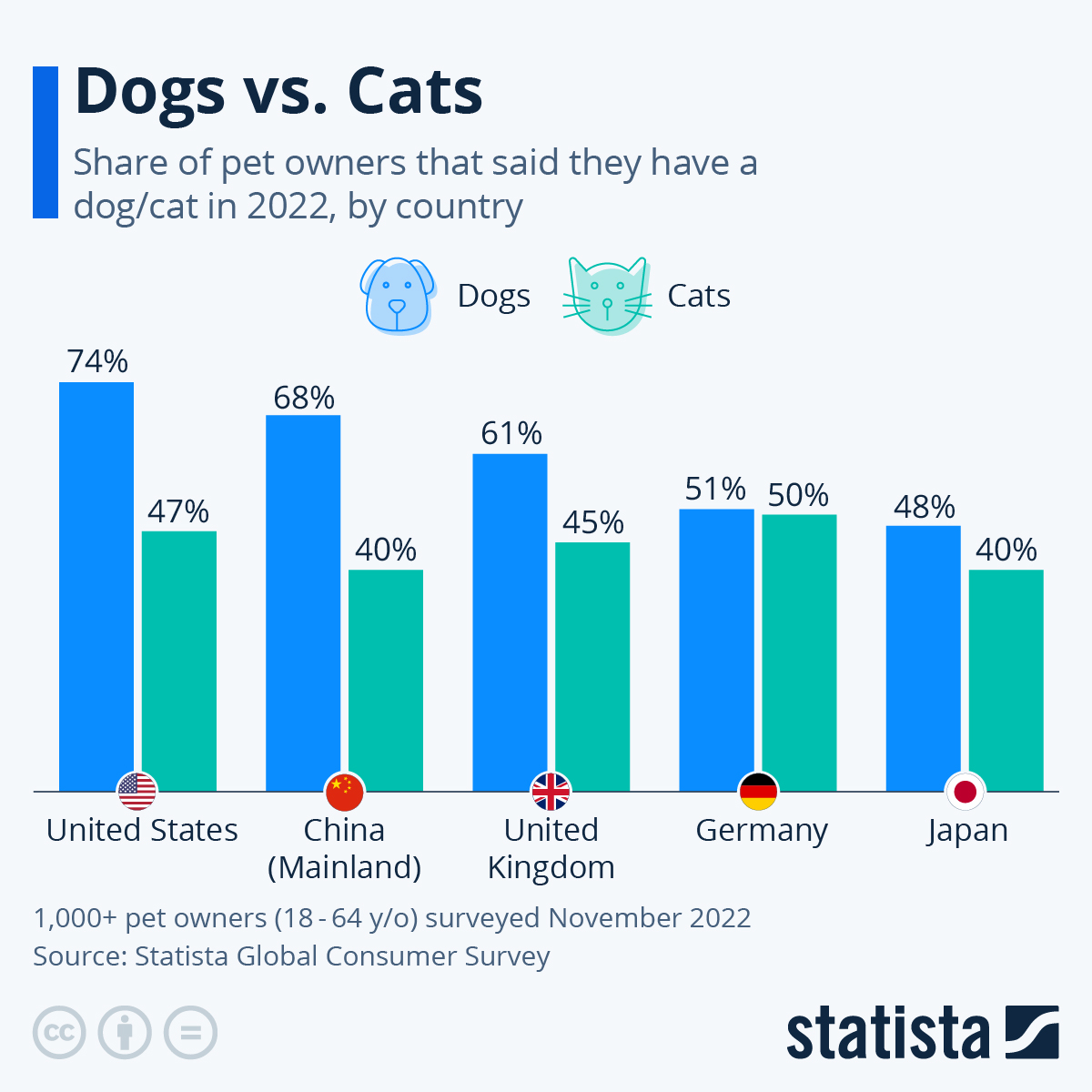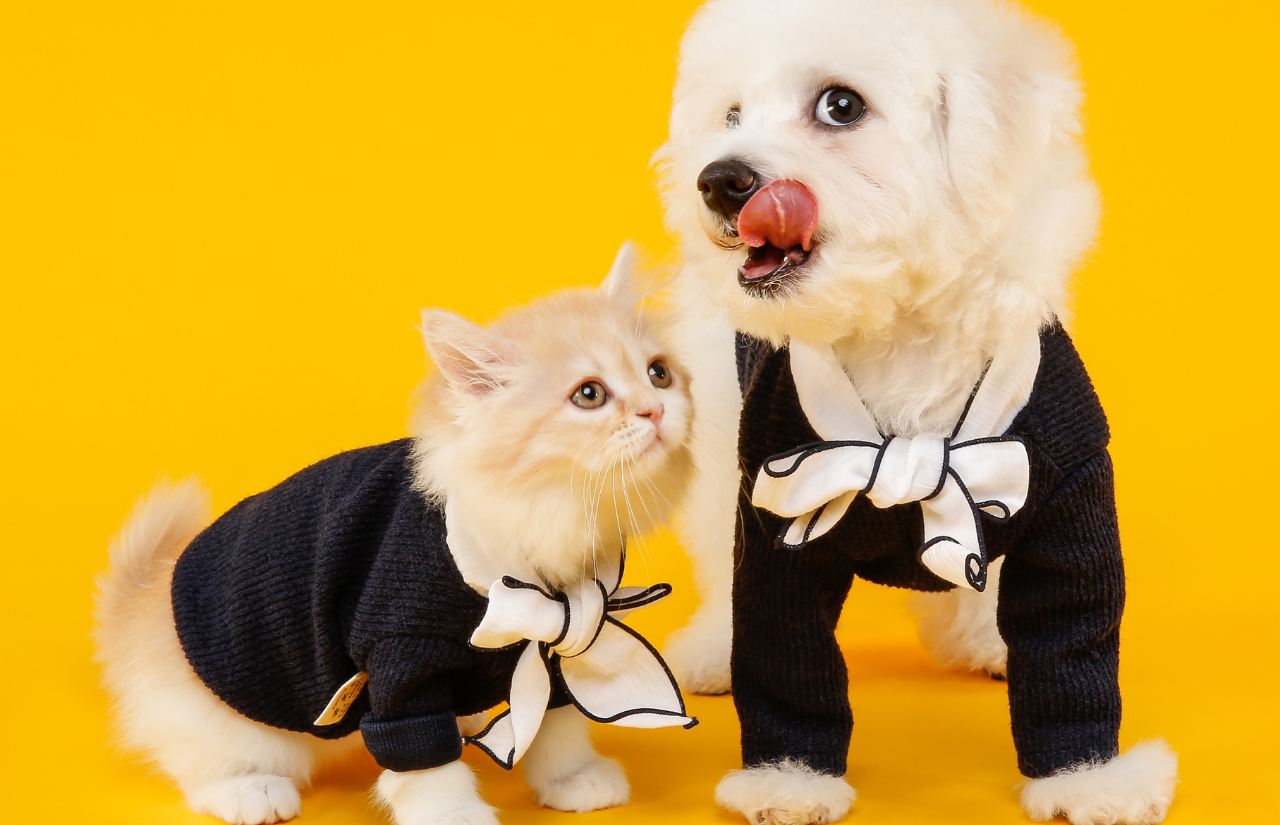For centuries, the age-old debate of dogs vs. cats has been a topic of discussion among pet enthusiasts. While the internet might be flooded with adorable cat memes and videos, recent statistics suggest that our canine companions might just have the upper paw in certain parts of the world. Dive into this comprehensive analysis to discover which furry friend reigns supreme in selected countries and why the scales might be tipping in favor of our loyal, tail-wagging buddies.
Table of Contents
Global Pet Trends
U.S. Dog Dominance
European Pet Preferences
Asian Animal Affection
Why Dogs Lead the Pack
Conclusion
Global Pet Trends
As we embark on a journey to understand the global dynamics of pet ownership, it’s evident that the world’s love for animals knows no bounds. Different regions, with their unique cultural, historical, and socio-economic backgrounds, have shaped the way people perceive and interact with pets. The Statista Global Consumer Survey offers a window into these diverse pet ownership patterns, revealing intriguing insights into the age-old debate of dogs vs. cats.
A Historical Perspective
The bond between humans and animals traces back thousands of years. Ancient civilizations revered animals, often associating them with gods or using them as symbols of power and status. In Egypt, cats were considered sacred and were even mummified, while in various cultures, dogs were seen as protectors and hunters. This historical reverence has evolved over time, with pets now being considered cherished family members in many households worldwide.
Urbanization and Pet Ownership
One of the significant factors influencing global pet trends is urbanization. As more people migrate to cities in search of better opportunities, living spaces become compact, and lifestyles change. In densely populated cities, smaller pets like cats, which require less space and maintenance, often become the preferred choice. On the other hand, suburban or rural areas with more open spaces might see a higher inclination towards dog ownership, where these energetic companions can roam freely.
Economic Factors
The economy plays a pivotal role in pet ownership trends. In affluent societies, where disposable incomes are higher, there’s a noticeable trend of pet humanization. People are willing to spend more on premium pet food, healthcare, grooming, and even luxury pet services. This economic capability often translates to a higher rate of pet ownership, with dogs, in particular, benefiting from such trends due to their diverse needs.
Cultural Influences
Culture profoundly influences pet preferences. In some cultures, dogs are revered for their loyalty and are often associated with protection and security. In contrast, cats might be seen as symbols of mystery and independence in others. Festivals, folklore, and local traditions also play a role in shaping a region’s affinity towards certain pets.
Environmental Considerations
The environment and climate can also dictate pet ownership trends. In colder regions, breeds like the Siberian Husky or the Saint Bernard might be more popular due to their adaptability to chilly temperatures. Conversely, in tropical climates, smaller and short-coated breeds might be preferred. Similarly, cats, with their ability to adapt to various environments, can be found in diverse habitats, from chilly mountainous regions to warm coastal areas.
In conclusion, the global pet trends are a mosaic of various influences, each adding its unique color to the vibrant tapestry of pet ownership. As we delve deeper into the dog vs. cat debate, it’s essential to appreciate the myriad factors that shape these trends across the world.
Statista Global Consumer Survey
Based on the Statista Global Consumer Survey, the article reveals that in countries like the United States, mainland China, the United Kingdom, and Japan, dogs are more popular than cats. For instance, in the U.S., 74 percent of pet owners said they have a dog, while only 47 percent said they have a cat. However, in Germany, the competition between dog and cat ownership is close, with 51 percent of pet owners having dogs and 50 percent having cats.

Source: Statista
U.S. Dog Dominance
The United States, known for its diverse landscapes and equally diverse populace, has always had a special bond with pets. When it comes to the “dogs vs. cats” debate, the U.S. showcases a clear inclination towards our four-legged canine buddies. With 74 percent of pet owners claiming a dog as part of their family, compared to the 47 percent who have a feline companion, it’s evident that the scales tip in favor of dogs. But what drives this dog dominance in the U.S.?
America’s Love for Adventure
The American spirit is synonymous with adventure and exploration. Dogs, with their boundless energy and enthusiasm, perfectly complement this ethos. Whether it’s hiking in the Rockies, beach outings in California, or road trips across the vast landscapes, dogs make for the ideal travel companion. Their adaptability and eagerness to explore resonate with the adventurous American heart.
The Backyard Dream
The quintessential American dream often paints a picture of a beautiful home with a white picket fence and a spacious backyard. This dream, for many, is incomplete without a dog playing fetch or lounging on the grass. The availability of space in many American homes allows for larger dog breeds to thrive, further fueling the nation’s love for dogs.
Community and Socialization
Dogs play a pivotal role in community building. Dog parks, pet-friendly cafes, and community pet events are common across the U.S. These spaces not only allow dogs to socialize but also foster human interactions. In a way, dogs become the bridge that connects people, creating a sense of community and belonging.
Dogs vs. Cats: The Loyalty Factor
While cats are cherished for their independence and mystique, dogs are often celebrated for their unwavering loyalty. This loyalty aligns with the values many Americans hold dear, such as friendship, trust, and commitment. The bond between a dog and its owner is profound, often transcending the usual pet-owner relationship, evolving into a deep, familial connection.
Service and Therapy Roles
Dogs have found significant roles in service and therapy across the U.S. From guiding the visually impaired to assisting those with physical challenges or providing emotional support, dogs have showcased their versatility and sensitivity. Their ability to be trained for various roles and their innate desire to help has further solidified their dominant position in American households.
In wrapping up, while the U.S. showcases a clear preference in the “dogs vs. cats” debate, it’s essential to understand that this dominance stems from a blend of cultural, social, and environmental factors. The American landscape, both physical and cultural, provides the perfect backdrop for dogs to shine, making them an integral part of the American family tapestry.
European Pet Preferences
Europe, with its rich tapestry of cultures, histories, and landscapes, offers a fascinating insight into pet ownership dynamics. The continent, which has seen empires rise and fall, has always had a close relationship with animals, both wild and domesticated. When diving into the “dogs vs cats” debate within Europe, the narrative is as diverse as the continent itself. While some countries, like the UK, lean towards dogs, others like Germany present a closely contested scenario. But what underpins these varied preferences?
A Historical Affinity
Europe’s history with pets dates back millennia. From the royal courts of France and England, where dogs were often seen as symbols of status and luxury, to the farms of Eastern Europe, where cats were valued for their prowess in keeping pests at bay, the continent’s history is replete with tales of these beloved companions. This historical connection has undoubtedly influenced modern pet preferences.
Urban Living and Space Constraints
Many European cities, known for their architectural marvels and compact design, often pose challenges for pet ownership. Cities like Paris, Rome, and Amsterdam, with their apartment-style living, might not always be conducive to larger dog breeds. In such settings, cats, with their independent nature and minimal space requirements, often become the preferred choice. Their ability to thrive in smaller spaces without the need for frequent outdoor excursions makes them ideal for city dwellers.
Cultural Festivals and Traditions
Europe’s diverse cultural festivals and traditions also play a role in shaping pet preferences. For instance, in certain parts of Spain, dogs play a significant role in festivals and are paraded in elaborate costumes. Meanwhile, in countries like Russia, cats are considered good luck and are often associated with folklore and legends. These cultural nuances subtly influence the “dogs vs cats” dynamic across the continent.
Climate and Landscape
Europe’s varied climate and landscape also influence pet ownership. The colder northern regions, with their vast open spaces, are conducive to larger dog breeds that thrive in chilly conditions. In contrast, the warmer Mediterranean regions, with their coastal cities and apartment living, might see a higher prevalence of cat ownership.
Modern Lifestyle and Work Dynamics
The modern European lifestyle, characterized by longer work hours and frequent travel, has also impacted pet preferences. Dogs, which often require more attention and regular outdoor activities, might not always fit seamlessly into this dynamic. Cats, on the other hand, with their self-sufficient nature, can be left alone for extended periods, making them a practical choice for many Europeans.
In conclusion, the European narrative in the “dogs vs cats” debate is multifaceted, influenced by a myriad of factors ranging from history and culture to modern lifestyle dynamics. As Europe continues to evolve, so will its relationship with these beloved companions, reflecting the continent’s ever-changing ethos.
Asian Animal Affection
Asia, a continent of contrasts, from its sprawling metropolises to its serene countryside, has a rich tapestry of cultures, traditions, and beliefs. This diversity extends to the realm of pets, where the “dogs vs. cats” debate takes on unique dimensions influenced by historical, cultural, and socio-economic factors. Countries like Japan and mainland China have shown a pronounced preference for dogs, but what drives this affection, and how does it compare to the love for felines?
Ancient Civilizations and Reverence for Animals
Asia’s history with animals is deeply rooted in its ancient civilizations. In China, dogs were revered for their loyalty and were often associated with protection and prosperity. Cats, on the other hand, were celebrated in ancient Japan and were believed to bring good luck, as symbolized by the famous ‘Maneki-neko’ or the beckoning cat figurine. These historical associations have left an indelible mark on modern pet preferences in the region.
Urbanization and Modern Living
The rapid urbanization seen in many Asian cities has influenced pet ownership trends. Space constraints in bustling cities like Tokyo, Shanghai, and Mumbai make it challenging to own larger dog breeds. However, the rise of pet-friendly apartments and the human desire for companionship in fast-paced urban settings have kept the “dogs vs. cats” debate alive and dynamic. Cats, with their low maintenance and adaptability to apartment living, often find favor among urban dwellers.
Pop Culture and Media Influence
Asian pop culture has played a pivotal role in popularizing pet ownership. Korean dramas, Japanese anime, and Bollywood movies often feature pets, especially dogs, as central characters, influencing public perception and desire. The Shiba Inu’s rise to fame in Japan or the popularity of the Pomeranian in South Korea can be attributed to their portrayal in media and pop culture.
Social Status and Economic Growth
With Asia’s economic boom, pets, especially exotic breeds, have become symbols of affluence and status. Owning a unique dog breed or a pedigree cat is often seen as a mark of prosperity. This economic growth has also led to a surge in pet care industries, from luxury pet spas to gourmet pet food, further fueling the “dogs vs. cats” debate.
Traditions, Beliefs, and Superstitions
Asia, with its myriad of beliefs and superstitions, views pets through a unique lens. In certain cultures, dogs are considered lucky and are believed to ward off evil spirits. Cats, especially black ones, have a mixed reputation, being considered lucky in some regions and a bad omen in others. These deeply ingrained beliefs influence pet ownership choices and the overall dynamics of the “dogs vs. cats” narrative in the continent.
In essence, Asia’s relationship with dogs and cats is a reflection of its diverse cultural, historical, and socio-economic landscape. As the continent continues to evolve and modernize, the “dogs vs. cats” debate will undoubtedly take on new dimensions, shaped by the ever-changing Asian ethos.
Why Dogs Lead the Pack
The age-old “dogs vs. cats” debate has seen fervent arguments from both sides, with each pet lover championing the merits of their preferred companion. However, when we look at global trends and delve into the intrinsic nature of dogs, it’s evident that these loyal canines often have the upper paw in many regions. But what makes dogs stand out and often lead the pack in the hearts of humans?
The Evolutionary Bond
Dogs, often dubbed ‘man’s best friend,’ share a deep evolutionary bond with humans. This bond traces back thousands of years when early humans and wolves formed a symbiotic relationship. Wolves, the ancestors of modern-day dogs, helped humans in hunting, while humans provided food and security in return. This mutual relationship laid the foundation for the deep-seated bond we share with dogs today.
Loyalty and Companionship
One of the standout traits of dogs is their unwavering loyalty. Whether it’s a farmer’s dog guarding the livestock or a family pet waiting eagerly for its owner, dogs showcase a level of loyalty and companionship that’s hard to match. This fidelity resonates deeply with humans, making dogs an integral part of many households.
Trainability and Versatility
Dogs are incredibly versatile, capable of being trained for a myriad of roles. From herding sheep to assisting the visually impaired, from performing in dog shows to detecting narcotics at airports, dogs have showcased their adaptability time and again. This trainability, combined with their eagerness to please, makes them invaluable in various professional and personal settings.
Emotional Connect and Empathy
While the “dogs vs. cats” debate often highlights the independent nature of cats, dogs are celebrated for their emotional connect and empathy. Dogs have an innate ability to sense human emotions, offering comfort during distressing times and sharing in moments of joy. This emotional synchronization has therapeutic benefits, with dogs often being used in therapy sessions to alleviate stress and anxiety.
Physical Activity and Health Benefits
Dogs, with their boundless energy, often necessitate regular physical activity. This requirement indirectly promotes a healthier lifestyle for dog owners. From morning walks to playful sessions in the park, dogs ensure that their owners stay active. Numerous studies have highlighted the health benefits of owning a dog, including reduced risk of cardiovascular diseases, lower stress levels, and increased social interactions.
Cultural and Social Significance
In many cultures, dogs hold significant social and cultural importance. They are often associated with protection, loyalty, and prosperity. Festivals, folklore, and traditions across the world celebrate the role of dogs in human society, further solidifying their dominant position in the “dogs vs. cats” narrative.
In conclusion, while both dogs and cats have their unique charm and place in human hearts, dogs often lead the pack due to their multifaceted roles, deep emotional connect, and historical significance. As societies evolve and lifestyles change, the dynamics of pet ownership might shift, but the intrinsic bond between humans and dogs is likely to remain unbreakable.
Conclusion
The “dogs vs cats” debate is as old as the bond humans share with these beloved companions. Both animals, with their unique personalities and attributes, have carved special places in our hearts and homes. As we’ve journeyed through various regions, from the bustling cities of Asia to the historical landscapes of Europe, and delved into the intrinsic nature of dogs, it’s evident that the dynamics of pet ownership are multifaceted and deeply rooted in cultural, historical, and personal preferences.
More Than Just Numbers
While statistics provide a snapshot of pet ownership trends, the true essence of the “dogs vs cats” debate lies beyond numbers. It’s in the purr of a contented cat lounging in the sun, the wagging tail of an excited dog welcoming its owner, the stories shared by pet owners, and the memories created with these furry companions.
Adapting to Modern Dynamics
As the world continues to evolve, with urbanization, technological advancements, and changing lifestyles, the dynamics of pet ownership will also transform. The modern world, with its compact living spaces and fast-paced life, might see a rise in cat ownership due to their independent nature. Conversely, the therapeutic benefits of dogs, their roles in security and service, and the active lifestyle they promote might keep them at the forefront of pet preferences in many regions.
A Personal Choice
At the heart of the “dogs vs cats” debate is a personal choice. For some, the independent and mysterious nature of cats is enchanting, while for others, the loyalty and exuberance of dogs resonate deeply. Each pet owner has their tales of joy, laughter, challenges, and memories that shape their preference.
In the grand tapestry of pet ownership, both dogs and cats add vibrant colors, each with its unique shade and texture. While trends might shift and preferences may change, one thing remains constant: the unparalleled joy, comfort, and companionship these animals bring into our lives. Whether you’re team dog or team cat, the love and bond shared with these pets are treasures to cherish.

